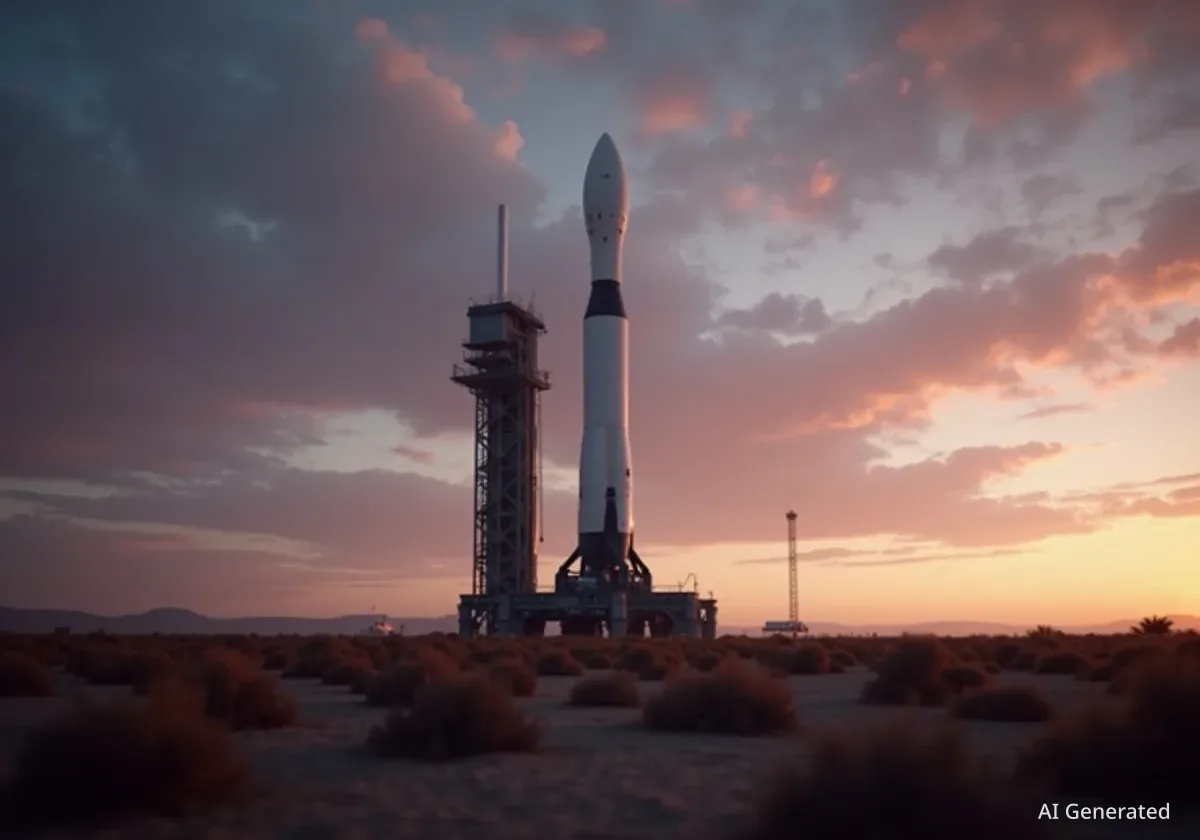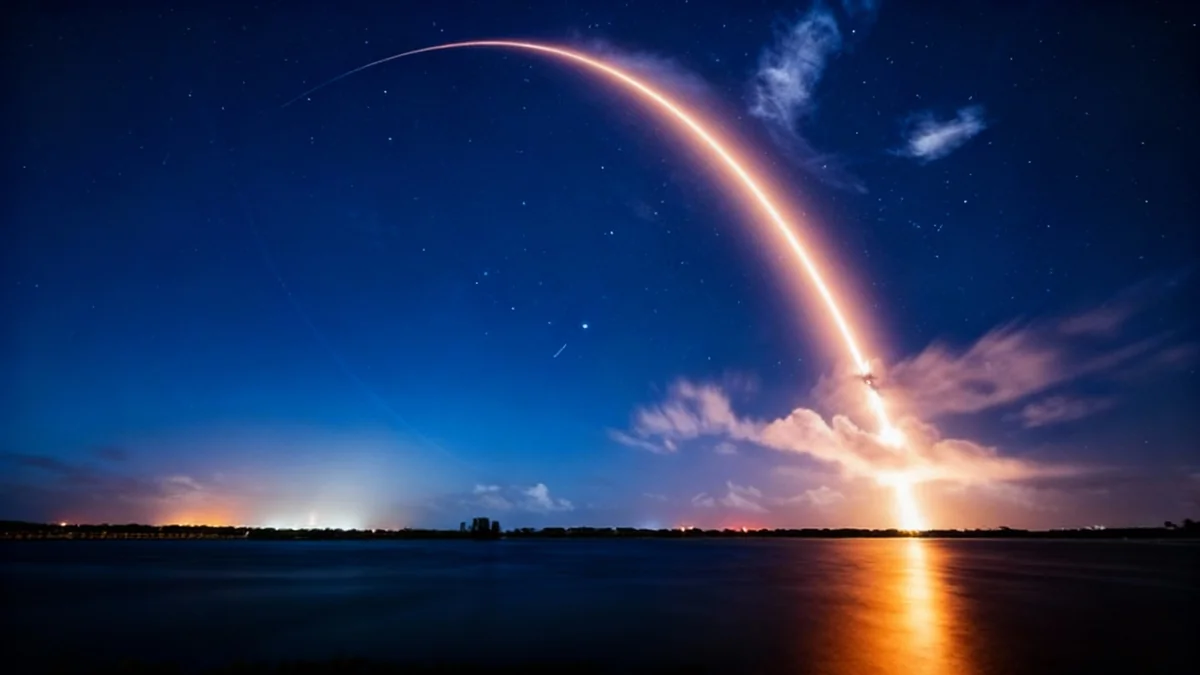Blue Origin is scheduled to launch its 15th human spaceflight mission, designated NS-36, on Wednesday, October 8. The New Shepard rocket will carry a crew of six passengers on a suborbital journey from the company's launch facility in West Texas. This flight is a highlight in a packed week that also includes five planned launches by SpaceX.
Key Takeaways
- Blue Origin's NS-36 mission will launch six passengers, including one returning astronaut, on October 8.
- SpaceX has a busy schedule with five Falcon 9 launches planned from both Florida and California.
- Missions this week include deployments for Starlink and Amazon's Project Kuiper satellite constellations.
- Looking ahead, SpaceX is preparing for the eleventh integrated flight test of its Starship vehicle.
Blue Origin's NS-36 Crewed Mission
Blue Origin's upcoming NS-36 mission marks another step in its commercial space tourism program. Liftoff is targeted for 9:00 a.m. EDT from Launch Site One in West Texas. The company plans to provide a live webcast of the event on its website, beginning approximately 30 minutes before the scheduled launch.
This flight will be the 15th time a New Shepard vehicle has carried humans to space. The mission aims to transport its crew beyond the Kármán line, the internationally recognized boundary of space located 100 kilometers (about 62 miles) above Earth.
The Six-Person Crew
The crew for the NS-36 mission includes a diverse group of individuals. Five of the six passengers have been publicly named:
- Jeff Elgin
- Danna Karagussova
- Dr. Clint Kelly III
- Aaron Newman
- Vitalii Ostrovsky
The identity of the sixth crew member will be revealed after the flight is completed, a practice Blue Origin has used in previous missions.
Notably, this mission will be the second spaceflight for Dr. Clint Kelly III, who previously flew aboard the NS-22 mission. His return makes him one of a small group of private citizens to have flown to space more than once.
The Suborbital Experience
Passengers aboard the New Shepard capsule will experience several minutes of weightlessness at the peak of their flight. They will have the opportunity to float freely inside the cabin and view the curvature of the Earth and the blackness of space through large windows before returning for a parachute-assisted landing in the Texas desert.
A Busy Week for SpaceX
While Blue Origin's human flight is a major event, SpaceX is preparing for a high-tempo launch week with five Falcon 9 missions on its manifest. These launches will support the expansion of satellite internet constellations for both SpaceX's Starlink and Amazon's Project Kuiper.
The launches are scheduled from both of the company's primary U.S. launch sites in Florida and California, demonstrating its operational capacity.
East and West Coast Launch Schedule
The series of launches begins early Tuesday and continues through the weekend.
- Tuesday, Oct. 7: A Falcon 9 is set to launch the Starlink Group 10-59 mission at 12:13 a.m. EDT from Cape Canaveral, Florida.
- Wednesday, Oct. 8: Another Falcon 9 will launch the Starlink Group 11-17 mission at 12:00 a.m. EDT from Vandenberg Space Force Base, California.
- Thursday, Oct. 9: SpaceX will launch the KF-03 mission for Amazon's Project Kuiper at 9:34 p.m. EDT from Cape Canaveral.
- Sunday, Oct. 12: A doubleheader is planned, starting with the Starlink Group 10-52 launch at 4:11 a.m. EDT from Florida, followed by the Starlink Group 11-19 launch at 6:59 p.m. EDT from California.
Recap of Recent Launches
The previous week, from September 29 to October 5, featured two U.S. launches. Rocket Lab conducted a suborbital flight for a government customer on September 30 from Virginia using its HASTE vehicle. On October 3, SpaceX launched the Starlink Group 11-39 mission from its base in California.
Looking Ahead to Starship and Beyond
The space industry is also looking forward to the following week, which may feature the eleventh integrated flight test of SpaceX's Starship. The launch could occur as early as Monday, October 13, from the company's Starbase facility in Texas.
This test flight will introduce new objectives designed to push the vehicle's capabilities. According to reports, SpaceX plans to test a new engine configuration for the Super Heavy booster's landing burn. The company also intends to intentionally remove some of Starship's thermal protection tiles to stress-test the heatshield during atmospheric reentry.
Starship's Role in NASA's Artemis Program
These developmental tests are critical for SpaceX's goal of creating a fully and rapidly reusable launch system. The success of the Starship program is foundational to NASA's Artemis program, which aims to return humans to the Moon.
Starship has been selected by NASA to serve as the Human Landing System (HLS) that will transport astronauts from lunar orbit down to the surface of the Moon for the first time since the Apollo program.
Beyond the Starship test, the manifest for next week also includes a Falcon 9 launch on October 14 for the Space Development Agency's Tranche 1 Transport Layer C mission, and another Starlink launch from Cape Canaveral on October 15.





